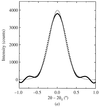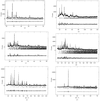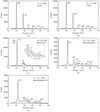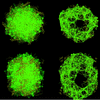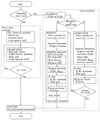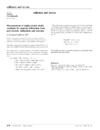issue contents
April 2000 issue

Cover illustration: Reorientation pathways of the octahedral PF6 anion in KPF6, calculated by an evolution algorithm. Courtesy of K. Knorr (University Kiel, Earth Sciences - Mineralogy) and Fritz Mädler (HMI Berlin) [J. Appl. Cryst. (1999), 32, 902-910].
research papers
Iron(II) complexes exhibiting thermal spin crossover may be converted from the 1A1 low-spin state to the 5T2 high-spin state by irradiation with green light (light-induced excited spin-state trapping, LIESST). The lifetime of the metastable LIESST state may be sufficiently long for X-ray diffraction study.
A non-linear positive method to reconstruct the parent textures from the inherited textures in phase transformation is presented. Its efficiency to reconstruct the parent textures even if small variant selection occurred is illustrated with numerical examples.
X-ray investigation and discussion of the magnetostriction of Gd3T (T = Ni, Rh, Irx) single crystals
The variations of the lattice parameters with temperature and anomalous anisotropic spontaneous magnetostriction of Gd3T single crystals were measured in the range 10–300 K.
SAXS experiments can be performed on an absolute scale with Kratky collimation systems using water as a secondary standard. The necessary basic equations are summarized and two examples demonstrate the performance of the method.
The new sample-rotation and area-detector-traverse method using X-ray optics for double-crystal X-ray topography was developed in order to measure variations in lattice distortion, free of extrinsic components, of an as-grown silicon single crystal.
Synchrotron X-ray absorption near-edge structure (XANES) spectroscopy studies have been carried out on the electronic and crystal structure environments of the Al atom in Na+ β-alumina and in two β-aluminas with Na+ exchanged by Li+ and Rb+. The aim is to define the type of interaction, if any, existing between the Al located in the `spinel block' and the fast-conducting cations in the `conduction plane'.
A 20 × 20 cm CCD-based X-ray detector designed for macromolecular crystallography is described. Measurements of performance and crystallographic data collected with synchrotron radiation are presented.
Taking a Ga0.5In0.5P/(001)GaAs epilayer as an example, it is found that the energy dependence of diffraction anomalous fine structure (DAFS) intensity is still sufficiently sensitive to structure parameters when the oscillating part is neglected. One reflection may already yield satisfactory data.
A procedure is proposed for the deconvolution of X-ray diffraction lines, based on series expansion of the `pure' profile.
The accuracy of the estimate of the weights calculated from the quantitative phase analysis (QPA) of complex mixtures which contain zeolites and clays using the combined Rietveld and reference intensity ratio (RIR) methods is assessed. The influence of fundamental factors, such as the choice of the structure model, the amount of added internal standard and the displacement parameters, is considered.
A new monoclinic ReO3 phase has been observed in the pressure range 3–12 GPa by energy-dispersive X-ray powder diffraction. ReO3 was shown to be rhombohedral above 12 GPa
The periodic tricontinuous network structure (TNS) of symmetric isoprene–styrene–2-vinylpyridine triblock copolymers has been studied by small-angle X-ray scattering (SAXS). The observed SAXS profiles were compared with the calculated diffraction intensities based on the model electron density distributions constructed for a pair of surfaces parallel to the infinite periodic minimal surface.
In order to improve significantly data collection efficiency, the advantages of using multi-wavelengths in single-crystal neutron diffraction as well as in powder neutron diffraction were established by experiments using a stacked monochromator assembly of two elastically bent perfect Si(111) and Si(220) crystals.
The description of line profiles from f.c.c. metals containing stacking and twin faults, as derived by Warren, has been revised and extended. It is discussed how fault probabilities can be determined from line profiles and it is shown by simulation that the revision leads to significantly better results.
An automatic procedure finds an allowed origin in the actual space group when the structure is solved in P1 by direct methods.
The validities of the d–sin2ψ method, a low incident-beam-angle method and the crystallite-group method are determined for thin titanium nitride coatings, taking the crystallographic texture into account.
Intensity profiles obtained for single and multiple diffraction are derived in the framework of the kinematical theory for a spherically shaped crystal.
Expressions for the extinction-corrected mean thickness and integral width for spherical crystals suitable for use in the development of crystallographic software are discussed.
Both analytical and Monte Carlo numerical models for the calculation of the neutron transmission function in the sampling volume through a radial collimator are presented. It is shown that the transmission function is sensitive to the parameters of the collimator, particularly, the collimator length and the number of blades.
An approach to the problem of anisotropic line broadening due to structural defects is developed for powder diffraction structure analysis. The application of this approach in structural investigations of trans- and β-trans-[Pd(NH3)2X2] (X = Cl, Br, I) overcame the problem of broadening and allowed precise and self-consistent information about the structure and microstructure of these compounds to be obtained.
A commercial crystallization robot has been modified for use in setting up sitting-drop vapor-diffusion crystallization experiments, and for setting up protein crystallization screens in situ. The primary aim of this effort is the automated screening of crystallization of integral membrane proteins in detergent-containing solutions; however, the results of this work are of general utility to robotic liquid-handling systems.
A reconstruction algorithm is described that yields three-dimensional models from one-dimensional small-angle X-ray scattering data of biomolecules in solution.
A novel experimental technique that employs high-energy synchrotron radiation is used for the investigation of through-thickness texture gradients in cold-rolled aluminium plates. Experimental aspects and potentials of the new technique are discussed.
Large single crystals (up to 5 × 5 × 4 cm ) of optical quality were grown from aqueous solutions containing a surplus of nitric acid using a standard evaporation method at 311 K. The main structural feature is the diaquapentanitratolanthanide(III) group, [RE(NO3)5(H2O)2].
Using high-precision refractive indices, phase-matching conditions for second-harmonic generation have been analysed.  coefficients have been determined from Maker fringe experiments and interpreted using a simple model (summing the molecular hyperpolarizabilities of the NO3 group).
coefficients have been determined from Maker fringe experiments and interpreted using a simple model (summing the molecular hyperpolarizabilities of the NO3 group).
teaching and education
Free 

An apparatus for preparing single crystals from the melt in a school laboratory is described.
laboratory notes
A parallel-beam X-ray diffraction geometry using X-ray guide tubes is proposed to eliminate preferred-orientation effects in powder X-ray diffraction (XRD) patterns and for new applications of XRD.
short communications
The classical R factor was correlated with the number of independent atoms for structures contained in the Cambridge Structural Database. The findings have an important bearing on the R factor to be expected for a structure of a given size, in particular for large-molecule structures.
The Huber G670 Guinier powder diffractometer provided high-quality Rietveld-refinable data in a matter of seconds using a synchrotron source.
A method is proposed, and preliminary experiments are described, for collection of X-ray data from macromolecular crystals in situ. The usual processes of mounting for either room-temperature or cryogenic X-ray data collection are eliminated by growing crystals, using vapor diffusion, on small supports or films that can be either frozen or treated before transfer directly to the X-ray beam.
computer programs
A brief description is given of the C-program ROD with which surface structures can be refined on the basis of X-ray data.
ShakePSD (filtering using the Patterson function, search procedures and direct methods) is a single program for organic compounds (running under Windows on a PC). The program can discriminate whether a heavy atom is included or not and can apply direct methods (Patterson function and search for all remaining atoms) or direct methods (tangent formula and/or minimal function).
laboratory notes
A beam-stop holder is described that allows for easy removal during alignment and calibration measurements and then for precise repositioning prior to data collection.
computer program abstracts
An upgraded version of SYMMOL is presented, including the possibility of discovering the I, Ih, C∞v and D∞h groups and of making easier the symmetrization of clusters with large deviations from the maxiumum symmetry.
addenda and errata
Free 

Correction is made to an equation in a paper by Howard & Kisi [J. Appl. Cryst. (1999>), 32, 624–633] and additional references are cited.


 journal menu
journal menu

















